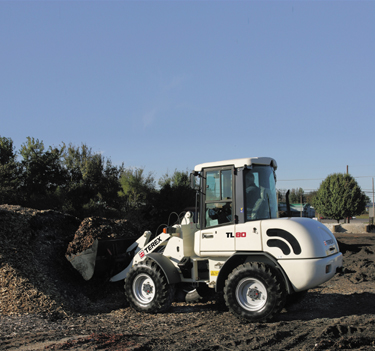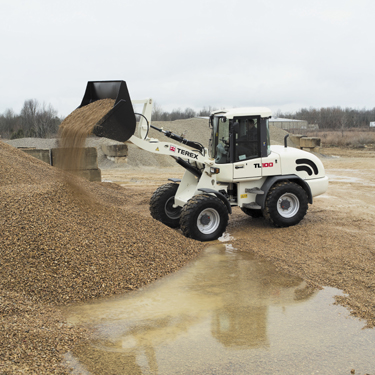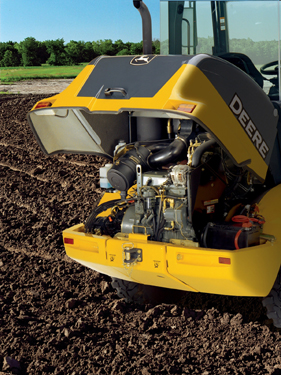Wheels of Fortune
 The iron will of a wheel loader makes it one of the most productive pick-and-place machines on the jobsite. With a metal bucket or steely set of pallet forks, a compact wheel loader can move more product or spoils than most small machines combined. But with great power comes great responsibility, which means plenty of preventative maintenance when it comes to a compact wheel loader. To keep your wheel loader running at peak efficiency, investing in a thorough maintenance program is money well spent. By following a few simple tips, you can help your compact wheel loader do what it is supposed to — make money for you and your crews.
The iron will of a wheel loader makes it one of the most productive pick-and-place machines on the jobsite. With a metal bucket or steely set of pallet forks, a compact wheel loader can move more product or spoils than most small machines combined. But with great power comes great responsibility, which means plenty of preventative maintenance when it comes to a compact wheel loader. To keep your wheel loader running at peak efficiency, investing in a thorough maintenance program is money well spent. By following a few simple tips, you can help your compact wheel loader do what it is supposed to — make money for you and your crews.
Tip #1: Set Up a Regular Maintenance Schedule
The first task for any preventive maintenance program isn’t even performed on the machine. As an owner and/or operator, you should develop an inspection plan, based on the manufacturer’s recommended guidelines, that incorporates a timeline and personnel assignments for specific tasks to be completed.
“The inspection plan starts as a simple checklist. Ultimately, it should become a habit operators automatically do at the start and end of each day,” says Bill Parker, Terex compact wheel loader product manager.
Once your inspection plan is finalized, it is easy to preprogram your compact wheel loader’s GPS unit to notify you exactly when the regular maintenance tasks need to be completed and to determine when to schedule the unit’s next service check. If you don’t have the luxury of a GPS system, make sure to create a detailed maintenance log book.
Compact wheel loaders should be thoroughly inspected before putting the machine into initial operation, according to Parker. After this inspection, a regular maintenance schedule for compact wheel loaders includes daily (every 10 operating hours), weekly (every 50 operating hours), six-month (every 500 operating hours) and annual (every 1,000 operating hours) inspections and service.
Tip #2: Keep It Simple
Daily maintenance routines should be simple and easy to follow, yet provide attention to detail. According to Parker, it is easier to deal with things little by little rather than have something fail and face the consequences — costly repairs and expensive downtime.
“Owners and operators need to see the value of a daily maintenance program or they won’t do it,” says Shannon Fethke, co-owner of EQUIPCO, a Terex dealer in New Orleans. “The machine needs daily attention so it continues to perform in the field. If the machine isn’t regularly cleaned, lubricated and serviced, it will slow down or freeze up, causing more downtime to fix than it would have taken to handle the little tasks every day.”
The best person to complete the daily maintenance is the operator — the one who knows the most about the machine’s particular sounds and performance. Before the workday begins, it is important to check the main fluid levels, including the hydraulic oil, engine oil, fuel and windshield wiper fluid and refill if necessary.
The next step is to walk around the machine, checking for damage from the previous day. Your visual inspection should also include checking for leaks and making sure all the machine’s systems are lubricated and functioning properly. According to Parker, have a grease gun handy to lubricate the systems if necessary.
“Operators need to pay close attention to details during the morning walk-around, logging completed action items and noting anything that does not pass inspection,” says Parker. “If anything needs to be repaired or replaced, do it immediately and report back to the person responsible for the equipment fleet.”

“It is essential that, at the end of the day, operators not only report the hours on the unit but how it is being used during the day. For example: Is it driving hard into piles? What kind of materials is it handling? How far are the materials being transported?” says Parker.
Tip #3: Preventive MaintenanceIncreases Your Loader’s Longevity
The good operating condition and life expectancy of any compact wheel loader is largely influenced by regular care and maintenance, says Parker. At the 50-hour mark, your compact wheel loader should go through a more extensive inspection. You or your company’s service department can perform these tasks depending on available resources.
This weekly inspection includes checking: the condition of the tires, tire pressure and tightness of the wheel nuts; the axles and propeller shaft fastenings; the bearing bushings and the pins/bolts; the articulated steering linkage assembly; the brake functions; and the function of all the safety devices.
You should also check if the dust filter in the cab’s ventilation system is dirty, because accumulation of dust can cause significant machine damage. The dust filter should be cleaned each week. During this check up, you should drain the fuel filter and properly lubricate the machine according to the manufacturer’s guidelines.
“One-week inspections are also a good time to review manufacturer service bulletins and make updates as recommended,” says Parker.
Around the 100-hour mark, your inspection needs to include additional tasks such as draining the water from the fuel tank and bleeding the brakes. Check several machine components, including the air intake, the V-belt tension, the engine mount and pump attachment and the engine speed settings. It is also a good idea to check the upper and lower idle speeds, the acid level and battery connections, as well as the machine’s hydraulic functions. The insert of the hydraulic oil return suction filter also needs to be replaced at this point. You should check the oil on the front and rear axle differentials as well as the wheel hubs on both axles, changing the oil if necessary.
Tip #4: Don’t Ignore the Long-Term Tasks
Missing one inspection or skipping a regular maintenance check could cause downtime, and seriously cut into the bottom line. To keep short-term maintenance simple, long-term maintenance checks are crucial.
Once your compact wheel loader hits the six-month mark, the engine oil and filter and the fuel filter need to be changed. Normal daily and weekly checks should be done with extra attention.
“The six-month check is a good time for the operator and the service technician to have an open discussion about how the machine is being used day in and day out, as well as how it’s performing,” says Parker. “Also, it is a good time to look at the maintenance records to spot any patterns.”

“Too often, the little things can be an indication of larger problems,” says Parker. “Owners, operators and service technicians should never ignore these warning signs.”
On an annual basis, your compact wheel loader should get a complete once-over. This is a good time to replace the cab’s ventilation dust filter, change the hydraulic oil, replace the breather and the brakes and change the oil in the wheel hubs and axle differentials.
Tip #5: Keep Your Dealer in the Loop
According to Fethke, everyone in contact with your machine is accountable for the success of its preventive maintenance program. Field supervisors need to make sure that the operators are doing the daily tasks. Fleet managers need to confirm with the field supervisors and operators that the machines are being maintained each day, as well as what repairs have been done or are needed. All of this information should go on file with your company and equipment dealer.
EQUIPCO encourages its customers to regularly communicate replacement and service needs, according to Fethke. If your dealer has your compact wheel loader’s model number, serial number, engine hours and service record on file, they can provide the necessary parts and service when needed.
“It helps us to know when the machine was serviced, where any damage occurred and what repairs were done,” says Fethke. “The more we know about the machine’s symptoms, the quicker we can diagnosis any problems.”
Fethke and his team want EQUIPCO customers to report back how often they change the oil, fuel filters, air filters and hydraulic filters. Also, Fethke wants to know about any recent changes in the machine’s behavior — for example, if the machine is running hot or if it is sluggish.
“Through the process of elimination, we can more easily understand what repairs are needed and get the machine back in the field as soon as possible,” says Fethke. Fethke’s advice: To maximize the life of your compact wheel loader, invest in a preventive maintenance program. Maintaining a regular maintenance schedule and following the prescribed action items will keep your compact wheel loader up and running for a long time to come.
Off-Season Storage
Pre-Hibernation Guidelines for Compact Wheel Loaders
Preventive maintenance procedures should be performed at the end of the working season or at any time your compact wheel loader will be sitting idle for an extended period of time.
Before being stored, your wheel loader should receive a thorough cleaning both inside and outside the machine, removing any contaminating materials – dirt, dust, sand, stone, concrete and more. After the cleaning process, your compact wheel loader should receive a thorough inspection, completing all of the regular maintenance action items, including lubricating the machine, refilling the fluid levels and checking the tire pressure. This is a good time to repair any paint damage and treat the machine with available corrosion protection agents. You should also repair or replace any suspect items.
If possible, your compact wheel loader should be kept indoors in a dry, dust-free room during the storage period. It is important to remove the battery before your wheel loader is secured for the off-season, cleaning it and storing it separately in a dry, frost-free room. One last thing to do is to close the air intake openings on the air filter system and the exhaust outlet on the exhaust pipe.
Starting your compact wheel loader up again after being stored is not as simple as turning the key. The first thing you must do is remove any anti-corrosion protection coating as well as open the air filter system and exhaust pipe feed. Next, you need to wash the machine thoroughly with a neutral cleansing agent, and before you re-install the battery, check and recharge it if necessary. Make sure you reference the engine operating manual for guidelines to get the diesel engine back into operation. Then, you should change the oil in all the assemblies, including the engine and gearbox, as well as replace the hydraulic filters.
Now your compact wheel loader is ready to go! After turning the key, give your compact wheel loader at least 15 minutes to warm before you put it in motion.

Comments are closed here.